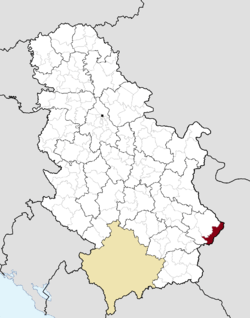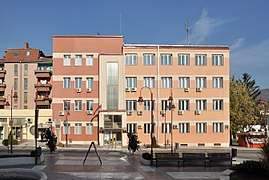Dimitrovgrad, Serbia
| Dimitrovgrad Димитровград Caribrod | ||
|---|---|---|
| Town and municipality | ||
 Panorama of Dimitrovgrad | ||
| ||
 Location of the municipality of Dimitrovgrad within Serbia | ||
| Coordinates: 43°01′N 22°47′E / 43.017°N 22.783°ECoordinates: 43°01′N 22°47′E / 43.017°N 22.783°E | ||
| Country |
| |
| Region | Southern and Eastern Serbia | |
| District | Pirot | |
| Settlements | 43 | |
| Government | ||
| • Mayor | Veselin Veličkov (DS) | |
| Area[1] | ||
| • Town | 17.10 km2 (6.60 sq mi) | |
| • Municipality | 483 km2 (186 sq mi) | |
| Elevation | 545 m (1,788 ft) | |
| Population (2011 census)[2] | ||
| • Town | 6,247 | |
| • Town density | 370/km2 (950/sq mi) | |
| • Municipality | 10,056 | |
| • Municipality density | 21/km2 (54/sq mi) | |
| Time zone | UTC+1 (CET) | |
| • Summer (DST) | UTC+2 (CEST) | |
| Postal code | 18320 | |
| Area code | +381(0)10 | |
| Car plates | PI | |
| Website |
www | |
Dimitrovgrad (Serbian Cyrillic: Димитровград, Bulgarian: Цариброд, Tsaribrod) is a town and municipality located in the Pirot District of southeastern Serbia. According to 2011 census, the municipality of Dimitrovgrad has a population of 10,118 people and the town 6,278.
Name
The official Serbian name is Dimitrovgrad (Димитровград), but the name Caribrod (Цариброд) is also used in Serbian. In Bulgarian, the name Tsaribrod (Цариброд) is preferred because there is another town called Dimitrovgrad on the Maritsa river in Bulgaria and Tsaribrod was used before the town was named after Georgi Dimitrov, a Bulgarian Communist leader who advocated a union between the Bulgarians and remaining Yugoslav nations to form the Balkan Federation. The idea was abandoned when Yugoslav leader Josip Broz Tito failed to reach agreements with Joseph Stalin (Tito-Stalin split), however Dimitrov himself did not become unpopular in Yugoslavia from the breakdown and subsequently, the name of the town continued to be in honour of him despite many citizens themselves having preferred Caribrod.
There have been attempts to return the old name, Caribrod, but the last referendum, held on Sunday, June 13, 2004, was invalid due to a low turnout. Only 47.8% of the 9,811 voters on the electoral roll turned out to vote, while 50% was the required minimum. Of those who voted on the issue, 2,586 were in favour of keeping the name Dimitrovgrad, while 1,786 wanted the name Caribrod to be returned.[3]
Geography
Climate
Dimitrovgrad has a humid continental climate (Köppen climate classification: Dfb), that's very close to an oceanic climate (Köppen climate classification: Cfb).
| Climate data for Dimitrovgrad (1981–2010, extremes 1961–2010) | |||||||||||||
|---|---|---|---|---|---|---|---|---|---|---|---|---|---|
| Month | Jan | Feb | Mar | Apr | May | Jun | Jul | Aug | Sep | Oct | Nov | Dec | Year |
| Record high °C (°F) | 21.0 (69.8) |
23.0 (73.4) |
26.8 (80.2) |
31.4 (88.5) |
33.4 (92.1) |
38.2 (100.8) |
41.4 (106.5) |
37.4 (99.3) |
36.0 (96.8) |
33.4 (92.1) |
26.8 (80.2) |
20.8 (69.4) |
41.4 (106.5) |
| Average high °C (°F) | 4.0 (39.2) |
6.1 (43) |
11.4 (52.5) |
16.9 (62.4) |
22.0 (71.6) |
25.3 (77.5) |
27.8 (82) |
28.1 (82.6) |
23.4 (74.1) |
17.8 (64) |
10.5 (50.9) |
5.1 (41.2) |
16.5 (61.7) |
| Daily mean °C (°F) | −0.7 (30.7) |
0.6 (33.1) |
5.0 (41) |
10.1 (50.2) |
14.9 (58.8) |
18.2 (64.8) |
20.1 (68.2) |
19.8 (67.6) |
15.3 (59.5) |
10.5 (50.9) |
5.0 (41) |
0.8 (33.4) |
10.0 (50) |
| Average low °C (°F) | −4.3 (24.3) |
−3.6 (25.5) |
−0.1 (31.8) |
4.1 (39.4) |
8.5 (47.3) |
11.6 (52.9) |
13.0 (55.4) |
12.9 (55.2) |
9.4 (48.9) |
5.4 (41.7) |
1.0 (33.8) |
−2.6 (27.3) |
4.6 (40.3) |
| Record low °C (°F) | −29.3 (−20.7) |
−23.5 (−10.3) |
−16.8 (1.8) |
−8.2 (17.2) |
−2.3 (27.9) |
1.5 (34.7) |
3.9 (39) |
2.4 (36.3) |
−3.5 (25.7) |
−7.9 (17.8) |
−17.0 (1.4) |
−18.0 (−0.4) |
−29.3 (−20.7) |
| Average precipitation mm (inches) | 39.5 (1.555) |
38.1 (1.5) |
40.2 (1.583) |
54.3 (2.138) |
67.2 (2.646) |
70.0 (2.756) |
61.1 (2.406) |
52.5 (2.067) |
51.8 (2.039) |
50.2 (1.976) |
52.8 (2.079) |
46.9 (1.846) |
624.7 (24.594) |
| Average precipitation days (≥ 0.1 mm) | 12 | 12 | 12 | 14 | 13 | 12 | 9 | 8 | 9 | 9 | 11 | 13 | 135 |
| Average snowy days | 9 | 9 | 7 | 1 | 0 | 0 | 0 | 0 | 0 | 0 | 4 | 8 | 39 |
| Average relative humidity (%) | 81 | 77 | 70 | 67 | 69 | 70 | 66 | 66 | 71 | 75 | 79 | 82 | 73 |
| Mean monthly sunshine hours | 81.4 | 99.1 | 148.1 | 166.5 | 221.1 | 258.3 | 299.3 | 280.9 | 212.1 | 157.9 | 94.8 | 65.0 | 2,084.5 |
| Source: Republic Hydrometeorological Service of Serbia[4] | |||||||||||||
History
The Roman road Via Militaris was built in the 1st century AD and went through the town. In May 2010, well-preserved remains of the road were excavated during the work on Corridor 10.[5]
An Ottoman military base operated in the west of Dimitrovgrad prior to the Balkan nations full independence.[6]
The Serbian and Bulgarian Prime ministers met at the then Tsaribrod in 1912 to discuss the disputed territories in Macedonia.[7] The Kingdom of Serbs, Croats and Slovenes gained parts of the Principality of Bulgaria (known in Bulgaria as Western Outlands) which included Tsaribrod following the Treaty of Neuilly, signed on November 27, 1919.
From 1929 to 1941, Caribrod was part of the Morava Banovina of the Kingdom of Yugoslavia. It was occupied by Kingdom of Bulgaria between 1941 and 1944 during World War II.
Demographics
| Historical population | ||
|---|---|---|
| Year | Pop. | ±% p.a. |
| 1948 | 23,063 | — |
| 1953 | 22,082 | −0.87% |
| 1961 | 18,418 | −2.24% |
| 1971 | 16,365 | −1.17% |
| 1981 | 15,158 | −0.76% |
| 1991 | 13,488 | −1.16% |
| 2002 | 11,748 | −1.25% |
| 2011 | 10,118 | −1.65% |
| Source: [8] | ||
According to the 2011 census results, the municipality has 10,118 inhabitants.
Ethnic groups
Regardless of ethnic self-identification, most of the town's population speaks a South Slavic dialect usually called Torlak which includes linguistic features of both Serbian (especially phonology) and Bulgarian (postposed definite articles and lack of the infinitive verb form), as well as some entirely unique vocabulary.
Ethnic composition of the municipality:
| Ethnic group | Population |
|---|---|
| Bulgarians | 5,413 |
| Serbs | 2,819 |
| Romani | 68 |
| Yugoslavs | 59 |
| Macedonians | 38 |
| Croats | 16 |
| Others | 1,705 |
| Total | 10,118 |
Economy
The following table gives a preview of total number of employed people per their core activity (as of 2016):[9]
| Activity | Total |
|---|---|
| Agriculture, forestry and fishing | 9 |
| Mining | 5 |
| Processing industry | 317 |
| Distribution of power, gas and water | 23 |
| Distribution of water and water waste management | 192 |
| Construction | 37 |
| Wholesale and retail, repair | 250 |
| Traffic, storage and communication | 278 |
| Hotels and restaurants | 212 |
| Media and telecommunications | 22 |
| Finance and insurance | 22 |
| Property stock and charter | - |
| Professional, scientific, innovative and technical activities | 67 |
| Administrative and other services | 19 |
| Administration and social assurance | 412 |
| Education | 129 |
| Healthcare and social work | 175 |
| Art, leisure and recreation | 65 |
| Other services | 53 |
| Total | 2,289 |
Gallery
 Dimitrovgrad Town Hall
Dimitrovgrad Town Hall- Town center
 The cultural center on the main square
The cultural center on the main square
See also
References
- ↑ "Municipalities of Serbia, 2006". Statistical Office of Serbia. Retrieved 2010-11-28.
- ↑ "2011 Census of Population, Households and Dwellings in the Republic of Serbia: Comparative Overview of the Number of Population in 1948, 1953, 1961, 1971, 1981, 1991, 2002 and 2011, Data by settlements" (PDF). Statistical Office of Republic Of Serbia, Belgrade. 2014. ISBN 978-86-6161-109-4. Retrieved 2014-06-27.
- ↑ Archived 2011-07-25 at the Wayback Machine.
- ↑ "Monthly and annual means, maximum and minimum values of meteorological elements for the period 1981–2010" (in Serbian). Republic Hydrometeorological Service of Serbia. Retrieved February 25, 2017.
- ↑
- ↑ A Military Geography of the Balkan Peninsula at Google Books
- ↑ The Ottoman Empire and Its Successors, 1801–1927 at Google Books
- ↑ "2011 Census of Population, Households and Dwellings in the Republic of Serbia" (PDF). stat.gov.rs. Statistical Office of the Republic of Serbia. Archived from the original (PDF) on 14 July 2014. Retrieved 6 March 2017.
- ↑ "ОПШТИНЕ И РЕГИОНИ У РЕПУБЛИЦИ СРБИЈИ, 2017" (PDF). stat.gov.rs (in Serbian). Statistical Office of the Republic of Serbia. Retrieved 20 February 2017.
External links
| Wikimedia Commons has media related to Dimitrovgrad, Serbia. |
.svg.png)
